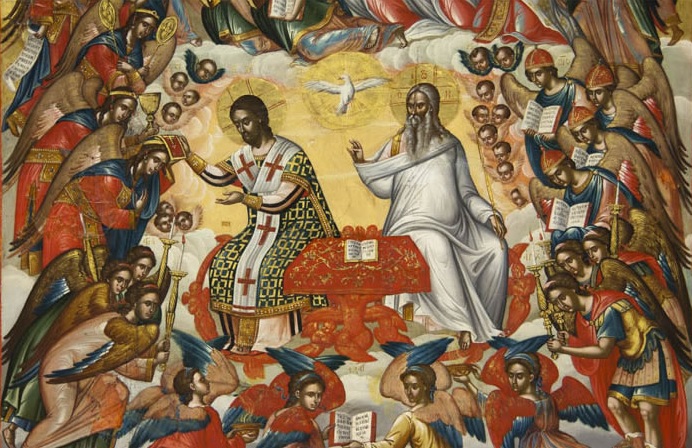Part 1. Why Study the Book of Revelation?
The apocalyptic genre in the Old Testament era
Apokalispsis—with this Greek word begins the book of St. John the Theologian, translated as “revelation.”
For modern man, the term “apocalypse” has a sinister meaning. In antiquity, it meant to remove the covering from something hidden, to reveal that which was concealed. It was like removing the sheet from a new painting or opening the curtain on a stage.
Over time, the concept began to be used to indicate the genre of those Jewish writings that appeared two centuries before Christ and continued into the first century after Christ.
There are fragments of apocalyptic literature in the Old Testament in passages from the books of Ezekiel, Joel, Daniel, Zechariah, and 3 Ezra. Biblical scholars refer to Isaiah 24-27 as the “Apocalypse of Isaiah.”
But the majority of the works of the apocalyptic genre are apocryphal. Such texts were usually written under the name of well-known righteous figures: Enoch, Abraham, Moses, Ezra, Baruch, the Twelve Patriarchs, and so on.
Such literature arose from a sense of the impossibility of getting the life of Israel back on track without the special intervention of God. The Jews’ hope for prosperity “here and now” was greatly weakened after a number of national catastrophes: the disappearance of most of the ten tribes in Media, the Babylonian captivity, and the Roman conquest of Palestine. Everything in this life is bad—meaning we have to wait for future prosperity.
The Old Testament apocalyptic genre also explained the meaning of present tribulations. They just need to be endured, while awaiting the “future age” when Israel will be blessed and the Gentiles will be punished by God.
Apocalyptic texts divided history into two ages: the present, completely depraved and awaiting destruction, and the coming age, in which there will be peace and prosperity, and the Jews will be rewarded and take their rightful place next to their Messiah. The present age will pass into the coming age thanks to the special intervention of God. The Jews called the day of His coming the Day of the Lord, which they saw as a horrible time of terror, destruction, and judgment.
The world is defiled and its death will be painful. But in this torment is born the “golden age.” In their descriptions, the authors used all their imagination, presenting the future “paradise” quite materialistically. For example, a fragment from the apocryphal Apocalypse of Baruch, the Son of Neriah (2 Baruch 29:5):
The earth also shall yield its fruit ten-thousandfold, and on each vine there shall be a thousand branches, and each branch shall produce a thousand clusters, and each cluster shall produce a thousand grapes, and each grape shall produce a cor of wine (450 liters—S.K.).
The “future age” of the Old Testament apocalyptic writers does not mean a completely new creation, but a recreation of the world anew. Such was God’s design, hidden until the time, but revealed to the apocalyptics. This idea is reflected in the book of St. John the Theologian.
Pre-Christian apocalyptic fragments often present the eschatological motif of the future resurrection of the dead. The righteous may die, but they will resurrect to blessedness in the new age. Sinners will also be resurrected for judgment and condemnation: Many of them that sleep in the dust of the earth shall awake, some to everlasting life, and some to shame and everlasting contempt (Dan. 12:2).
The apocalyptic genre is characterized by a thirst for the end: How long?... (Dan. 8:13); How long shall it be to the end (Dan. 12:6); “How and when will this be?” (3 Ezra 4:33). This motif is also reflected in St. John the Theologian: Even so, come, Lord Jesus (Rev. 22:20).
Nothing is said about the personal salvation of men in Old Testament apocalyptic literature. The main hero of these books is the people of God.
If we talk about the apocalyptic apocrypha of the Old Testament era, then these nameless authors could not rise to the level of a truly Biblical revelation. Reading their material, you understand the text is clearly “human,” with people’s imaginings, dreams, and phantasmagoria on religious themes… There is the glistening of prophetic vision, but not the vision itself. And there are many elements alien to the Biblical worldview that came into the Jewish culture of that time from the Greeks, Chaldeans, and Persians.
Apocalyptic and prophetic—what’s the difference?
What is the difference between apocalyptic and prophetic literature?
That which is revealed to prophets can be conveyed in word, while apocalyptic messages mostly cannot fit into verbal formulas, but rather are depicted through visions.
To the prophet, God says: “Go tell so-and-so such-and-such.” To the apocalyptic, He shows scenes, and the author depicts them in metaphors, symbols, allegories, and images.
The prophet is more interested in the present than the future. The prophet foretells the future so people would correct themselves in the present. The apocalyptic mostly thinks about the future; he is little interested in life here. Here there is only sin, vice, pain, and death—true life begins only in the “golden age.”
However, the apocalyptic genre is closely connected with the prophetic tradition. Apocalyptic writings often grow out of prophecy, and vice versa. There are many prophetic passages in apocalyptic literature, and apocalyptic passages in prophetic literature. Thus, St. John the Theologian defines his work not only as an apocalypse, but as a prophecy (cf. Rev. 1:1, 1:3, 22:19).
A characteristic feature of New Testament apocryphal apocalypses, as well as the Revelation of St. John the Theologian, is the close connection with Old Testament prophecies and images.
Apocalyptic literature has a special, mysterious language. Visions, complex allegories, “encrypted” images, symbolic numbers, colors, animals, plants—we find all these elements in the pages of both Old and New Testament apocalyptic writings.
The apocalyptic genre in the New Testament era
Numerous apocryphal apocalypses were also written in New Testament times, on Christian themes.
We know of apocalypses of Peter, James, Paul, the Most Holy Theotokos, another of John the Theologian, etc. Of course, the claimed authors are false, and the Church did not accept them into the New Testament canon. The Revelation of St. John the Theologian is the only Christian apocalyptic book included in the New Testament.
However, there are passages from other canonical New Testament books written in the apocalyptic genre: Mk. 13, Mt. 24:1-2, 1 Thess. 4:16-17, 2 Thess. 2:1-12.
Revelation is undoubtedly associated with pre-Christian apocalyptic literature. The same laws of the genre are at work here: the Jewish conception of two periods, as well as the standard set of events that should take place in the last times: socio-political cataclysms, natural disasters, supernatural cosmic cataclysms, the punishment of sinners.
These similarities suggest that the Old Testament apocalyptics were not without some prophetic intuition.
There is also an important difference: the replacement of the Day of the Lord with the Second Coming of Jesus Christ. The people of God in New Testament apocalypses are the Church, the Messiah is Christ, and the “golden age” is the Kingdom of God.
Christian apocalypses also differ from Jewish ones in that the age to come has already come to some extent, because Christ has already come.
Thus, opening the pages of the Revelation of St. John the Theologian, let us remember that the Old Testament Jewish consciousness went through a huge and tormented path in search of the meaning of its history and its future. It was a movement of conjecture, as if feeling their way in the dark.
We Christians have that of which the authors of pre-Christian apocryphas could only dream: the genuine revelation of God about the fate of the world and the Church. And even for this reason alone, the Revelation of St. John the Theologian deserves our attention and love.





